Table of contents
Cranberries ( Vaccinium macrocarpon ), also known as cranberries or large-fruited cranberries , can be eaten raw (preferably organic ) or cooked. They are particularly popular for baking and preparing sauces.
Use in the kitchen
Fully ripe, fresh, large-fruited cranberries or lingonberries, often also written as cranberries, are rarely available in Europe. They are usually found dried or frozen. The berries taste very sour and slightly bitter. When dried, they are therefore mostly found with sugar. Read about dried, sweetened cranberries , which are mainly used as a baking ingredient to enhance Christmas stollen, cakes, cookies or muesli bars, in the associated article.
Can you eat cranberries raw? If you like them sour and tart, you can eat the fully ripe cranberries raw - pure or sweetened with other fruits and a little sugar or another sweetener. In addition, a few raw cranberries not only add a nice color accent to salads, bowls and smoothies, but also a taste highlight.
How do you eat cranberries? The fresh berries are more often used for baking and cooking. In North America, the famous cranberry sauce is a must at Thanksgiving. Other savory sauces can also benefit from the flavor of cranberries, such as the cranberry-orange sauce with apple and fresh ginger , which goes excellently with all kinds of vegan, Christmas dishes. There are also preparations as jam, compote, chutney or juice, similar to the cranberry that grows in Europe. Also recommended are vegan cranberry casseroles (e.g. with quinoa , Brussels sprouts and sweet potatoes , or with potatoes and sauerkraut ) and cranberry pans (e.g. with couscous or rice ).
In recipes with fresh cranberries, you can easily replace them with dried ones. 100 g of fresh produce corresponds to about 50 g of dried cranberries. The dried berries can be soaked in water , cranberry juice or apple juice for a few hours and then drained and used like fresh berries.
The tart, sour note of fresh cranberries can be wonderfully complemented and rounded off with various herbs (e.g. rosemary , sage , spearmint ) and spices (e.g. cinnamon , allspice , ginger ,vanilla ). Feel free to experiment with different combinations.
Vegan recipe for banana bread with fresh cranberries
Ingredients: 150 g wheat flour or spelt flour , 150 g whole cane sugar , 2 teaspoons baking powder , 2 large ripe bananas , 80 ml rapeseed oil , 100 g fresh cranberries (organic).
Preparation: Mix flour, sugar and baking powder in a bowl. Peel bananas and mash them with a fork in another bowl. Add mashed bananas and oil to the flour-sugar-baking powder mixture and knead into a dough. Fold in rinsed, fresh cranberries. Pour the mixture into a greased dish or small muffin tins. Bake in a preheated oven at 170 °C for approx. 25 minutes.
Tea preparation
For one liter of tea you need about 150 g of fresh cranberries. Wash the cranberries and then squeeze out their juice. Alternatively, crush the berries. Boil cranberry juice or crushed cranberries with a liter of water and let it boil for about 5-8 minutes. Let the berries steep for about 20-30 minutes and let the tea cool down. Cranberry tea tastes particularly good sweetened with a little agave syrup .
Vegan recipes with cranberries (raw) can be found under the note: " Recipes that have the most of this ingredient ".
| Not only vegans or vegetarians should read this: Vegans often eat unhealthily. Avoidable nutritional mistakes . |
Shopping - Storage
Where can you find fresh cranberries? Fresh cranberries can only be found in well-stocked branches of selected supermarkets (e.g. Migros , Coop , Spar , Rewe ) or in online shops. Supermarket chains such as Denner , Volg , Aldi , Lidl , Hofer or Billa only have the large-fruited cranberry in their range in dried form, but all year round. Even in organic supermarkets (e.g. Denn's Biomarkt , Alnatura ) organic cranberries are usually only available in dried form. Dried cranberries are mostly sweetened with sugar , sometimes with pineapple juice or other fruit juices. The berries are available frozen at Coop , Rewe and Edeka (sometimes as a berry mix).
Prefer organically produced cranberries, because conventional cranberries in monoculture plantations cannot survive without the use of pesticides, which results in end products contaminated with pesticide residues. 1
The availability of cranberries (raw) varies depending on the size of the store, catchment area, etc. Our recorded food prices for the DA-CH countries can be found above under the ingredient image - and by clicking on them you can see their development at various suppliers.
Storage tips
Fresh cranberries can be safely stored in a plastic bag in the refrigerator for up to three months. Provided they are not damaged and are not too close together. Raw cranberries can also be frozen. This way they will last for up to a year.
To determine the freshness and ripeness of cranberries, there is the so-called bounce test. To do this, you drop a berry onto a table from a height of about 20 cm. Fresh, undamaged cranberries bounce back, the others do not.
Ingredients - Nutritional values - Calories
The energy content of raw cranberries is rather low at 46 kcal/100g. The fat content is 0.13 g and the protein content 0.46 g/100g. Large-fruited cranberries contain 12 g of carbohydrates per 100 g, of which 4.3 g are sugar. 2
The vitamin C (ascorbic acid) content of 14 mg/100g (18% of the daily requirement) is not one of the highest, but with a varied diet the berries contribute to the daily vitamin C requirement. Cranberries (12 mg/100g) and prickly pears (14 mg/100g) have similar values. Sea buckthorn berries are particularly rich in vitamin C with 450 mg/100g . 2
Vitamin E is found in cranberries at 1.3 mg/100g (11% of the daily requirement). Comparable amounts can be found in blackberries (1.2 mg/100g), blackcurrants (1.0 mg/100g) and cranberries (0.94 mg/100g). Nuts such as almonds (26 mg/100g) or hazelnuts (15 mg/100g) are a good source of vitamin E. 2
100 g of cranberries contain 0.27 mg of manganese , a similar amount to lingonberries (0.26 mg/100g) and blackcurrants (0.26 mg/100g). The manganese requirement can be easily covered with various nuts (e.g. hazelnuts: 6.2 mg/100g), seeds (e.g. pine nuts : 8.8 mg/100g; pumpkin seeds : 4.5 mg) and whole grains ( oat flakes : 3.6 mg). 2
Cranberries are rich in several classes of phytochemicals (secondary plant compounds). These include phenolic acids (hydroxybenzoic acid, hydroxycinnamic acid), flavonoids (flavan-3-ols, flavonols, anthocyanins, proanthocyanidins or condensed tannins), triterpenoids, benzoates and organic acids (citric acid, malic acid, quinic acid). 3,4 Factors such as variety, cultivation methods, geographical area, weather conditions, ripeness, harvest time and storage affect the content of phenolic compounds in cranberries. For example, cranberries grown in cooler weather have higher phenol content than specimens of the same variety grown in a mild climate. 3
The complete ingredients of cranberries (raw), the coverage of the daily requirement and comparison values with other ingredients can be found in our nutrient tables. In the article Nutrients explained you will get a detailed insight into the topic.
Health Effects
Are cranberries healthy? Cranberries ( Vaccinium macrocarpon ) are a good source of antioxidants such as polyphenols (flavonoids, phenolic acids, anthocyanins, tannins), ascorbic acid and triterpenes. Oxidative stress, i.e. large amounts of free oxygen radicals in the body, can cause many diseases. Antioxidant compounds can prevent or reduce oxidative cell damage. They play a crucial role in preventing the development of chronic diseases such as cardiovascular disease, degenerative diseases, inflammation, diabetes and cancer. 3
The best-known benefit of cranberries is the prevention and treatment of urinary tract infections (eg cystitis) thanks to their antibacterial properties. One of the possible mechanisms behind the protective effect of cranberries against urinary tract infections is the ability of proanthocyanidins to inhibit the attachment of Escherichia coli bacteria to the urinary tract mucosa. 3,4
However, the protective effect of cranberries against urinary tract infections is controversial in the literature. Although a large number of clinical studies provide evidence for this, the results of other studies do not show significant effects. It has also been found that the effectiveness of cranberries varies from individual to individual and/or case to case. This variability is attributed to different cranberry products and dosages, as well as the lack of systematic protocols for the selection of subjects and clinical tests. 4
The results of a 2010 study showed that consumption of dried cranberries improved prostate health in men with elevated PSA levels (which may indicate prostate cancer), histologically proven prostatitis (inflammation of the prostate), or bladder dysfunction. 5
Cranberries are also used to prevent stomach ulcers by suppressing the activity of the bacteria Helicobacter pylori in the stomach. Similar to the prevention of urinary tract infections caused by E. coli , a group of proanthocyanidins can inhibit the attachment of H. pylori to the stomach lining. This bacteria is known to cause gastritis (inflammation of the stomach lining), ulcers and stomach cancer. 3,6,7
The proanthocyanidins contained in cranberries are also said to have inhibitory effects on oral diseases such as caries and periodontitis. The cariostatic properties of cranberries have been proven in laboratory studies. Clinical studies are still lacking. 3,6 ,7 In addition, the ingredients contained in cranberries, when used as a mouthwash, are as effective as chlorhexidine (an antiseptic used in dentistry) against streptococci. 8
Other effects associated with cranberries include promoting digestive and heart health, improving gut microbiota , lowering cholesterol and blood pressure, reducing the risk of type 2 diabetes, preventing obesity and kidney disease, and antiviral properties. 3
Dangers - Intolerances - Side effects
Cranberries are generally well tolerated. However, high doses can cause stomach problems, diarrhea and nausea. 9,10
In addition, there are conflicting data on the role of cranberries in kidney stone formation. Some clinical studies suggest that people with a history of uric acid or calcium oxalate stones are at risk from consuming cranberry products, while other studies report that consuming large amounts of cranberries may inhibit kidney stone formation or reduce ionized calcium in urine associated with stone formation. 11
Some studies also reported a possible interaction between cranberries and anticoagulants. 9 However, according to a 2021 review study, no interactions were found with moderate consumption of cranberry juice. However, taking large amounts of cranberry juice (approx. 1-2 l) or cranberry extract (3000 mg/day) could interfere. 11
People who are allergic toblueberries or other Vaccinium species should be cautious when eating cranberries and avoid them if possible. 9
According to the Canadian government, you should not exceed 30 g of fresh cranberries per day. 12
Risk of confusion
The large-fruited cranberry ( Vaccinium macrocarpon ) can be confused with the bald rosemary ( Andromeda polifolia ). Its leaves are more similar to those of rosemary ( Rosmarinus officinalis ), but the flowers and fruits are similar to those of the cranberry. The andromedotoxin it contains has an aconite-like effect, which can lead to a burning sensation in the mouth, salivation, circulatory problems and swallowing problems when consumed. This can result in dizziness and intoxication. Larger doses can cause shortness of breath and, in the worst case, respiratory paralysis. 13
Use as a recognized medicinal plant
According to ESCOP and WHO, the fruits of the large-fruited cranberry ( Vaccinium macrocarpon ) are effective in preventing infections of the urinary tract. 14
Folk medicine - natural medicine
Native Americans knew about the diverse properties of the cranberry early on. They used the berries as a meat preservative and as a medicine to relieve various ailments, from scurvy to stomach and liver problems. The juice of the cranberry was used, among other things, to wash out wounds. 7, 13
Ecological footprint - animal welfare
The ecological footprint of a food depends on various aspects, such as cultivation method (conventional/organic), seasonality, country of origin, transport and, if applicable, packaging. The CO 2 footprint of raw cranberries is 0.73 kg CO 2 eq/kg according to The Big Climate Database. 15
A large proportion of cranberries in European supermarkets come from North America (USA, Canada). The transport distances are therefore relatively long. If possible, choose cranberries grown in Europe or switch to lingonberries or other European berries.
According to a Dutch study (2011), the water footprint of raw cranberries is 276 litres of water per 1 kg of cranberries. 16
In conventional agriculture, synthetic pesticides and herbicides are often used to combat unwanted plants and insects. These have been proven to have a negative impact on the environment and affect important pollinators, birds and mammals. Accordingly, when buying cranberries, you should buy organic products in order to protect biodiversity and your own health, among other things. The use of such pesticides is prohibited in organic farming.
Animal protection - species protection
The fruits of the cranberry are food for birds and small mammals. The plant also attracts pollinators. Species of the genus Vaccinium support specialised bee species in their natural ranges such as Andrena bradleyi , Andrena carolina , Panurginus atramontensis , Habropoda laboriosa , Colletes productus , Colletes validus and Osmia virga . 17
Worldwide distribution - cultivation
It was the Native Americans of North America who first discovered the usefulness and versatility of cranberries. They used cranberries in a variety of foods, including pemmican, a protein-rich mixture of dried meat, fat and cranberries. They also used the berries as a medicine to treat arrow wounds and as a dye for carpets and blankets. 18
The largest cranberry producers in 2022 were the USA (mainly Wisconsin, Massachusetts, New Jersey, Oregon) 19 , Canada (Quebec, British Columbia) 20 and Turkey. There are also cranberry growing areas in Europe. Ukraine, North Macedonia, Belarus and Azerbaijan are among the largest European growers. 21
About 95% of the harvested raw cranberries are processed into products such as juice drinks, sauces and sweetened dried cranberries . The remaining 5% are sold as fresh produce. 18
Found in the wild
Where do cranberries grow? Cranberries grow in cool, temperate areas with acidic soils, peat bogs, raised bogs and moorland heaths. 13,18 The original distribution area of the large-fruited cranberry ( Vaccinium macrocarpon ) extends from eastern Canada to the northeast of the USA. In the northwest of the USA and in Europe (Great Britain, Germany, Belgium, the Netherlands, Switzerland) it is considered a neophyte (introduced plant). 22
How do cranberries grow? The cranberry is an evergreen, creeping subshrub with low-growing tendrils that form slender, wiry stems up to 2 m long and 5-20 cm high. It has elliptical, dark green leaves, light pink flowers and large, round to slightly pear-shaped, red fruits. 3,18,23
Are cranberries and lingonberries the same thing? The confusing term "cultivated lingonberry" for the cranberry ( Vaccinium macrocarpon ) often leads to confusion with the lingonberry ( Vaccinium vitis-idaea ). Both plants belong to the blueberry genus ( Vaccinium ) and have red berries, but are two different species. Cranberries are significantly larger than the pea-sized lingonberries. Cranberries also come from North America, while lingonberries are native to Europe and Asia.
Cultivation - Harvest
Cranberries can only grow under a special combination of factors. These include acidic raised bog or peat soils, an adequate supply of fresh water and a growing season that lasts from April to November. Commercial growing areas use a system of wetlands, plateaus, ditches, gullies, ponds and other bodies of water. 24
The soil of cranberry consists of alternating layers of sand and organic matter. Over time, dead leaves accumulate, and every 2-5 years, sand must be added to the soil surface to encourage upright production and maintain productivity. Unlike normal agricultural soils, cranberry soil does not require tilling (plowing). 25
As a wetland-adapted plant, the cranberry is tolerant of flooded soils. However, during the active growing season (generally March through October), good drainage in the soil is essential for proper root growth and function. During this time, commercial cranberry bogs are managed with drained soils and are generally not flooded. Flooding is limited primarily to winter protection, harvesting, and some special pest control methods. 25
The harvest takes place once a year from mid-September to early November. 26 There are two methods of harvesting cranberries.
The main harvesting method takes advantage of the berries' ability to float (due to their air pockets). This method, known as wet harvesting, involves flooding cranberry fields with water. After flooding, the water is stirred up with eggbeater-like devices so that the berries detach from the vines and rise to the water's surface, from where they are pulled to shore. Wet-harvested cranberries are usually processed into juice, sauce or dried, sweetened cranberries , as wet berries are more likely to spoil. 18
Dry harvesting is the second method of cranberry harvesting, which uses lawnmower-like machines to comb fully ripe berries from the vines. Upon arrival at the factory, the dry-harvested cranberries undergo a test called the bounce test. Each berry must successfully jump over a series of wooden barriers on a conveyor belt. Those that pass the bounce test are of good quality and can be sold as fresh produce. 18
Today, there are some organic cranberry growers in North America who do not use artificial fertilizers or synthetic chemical pesticides in the cultivation of the fruit. The main problems faced by organic cranberry producers include weeds, pests and fruit rot, among others. However, the biggest problem appears to be a reduction in yield of 50% or more compared to conventional production. 27
Further information
The large-fruited cranberry ( Vaccinium macrocarpon ; formerly known as Oxycoccus macrocarpus 17 ) is a member of the heather family (Ericaceae), which also includes cranberries ( Vaccinium vitis-idaea ) andbilberries/blueberries ( Vaccinium myrtillus ). There are many varieties of cranberries, most with reddish berries. Important varieties include "Ben Lear," "Early Black," "Howes," "McFarlin," "Pilgrim," "Searles," and "Stevens." 28 The white cranberry is an early crop, picked two to three weeks before maturity. 18
The correct German name for the species is Grossfrüchtige Moosbere, but the English name is more common. "Cranberry" is probably derived from "craneberry" because the pink flowers that appear in spring are said to resemble the neck, head and beak of a sandhill crane. 3,18
In addition to the most well-known representative of the cranberries, the large-fruited cranberry ( Vaccinium macrocarpon ), there are also the small-fruited cranberry ( Vaccinium microcarpum ), the southern cranberry ( Vaccinium erythrocarpum ) and the common cranberry ( Vaccinium oxycoccus ), which are native to Central and Northern Europe. 7
Alternative names
What is cranberry in German? In German, the cranberry is called large-fruited mossberry, American craneberry or craneberry. However, the English name cranberry has become established internationally and is now more common in the German language.
The correct plural of cranberry in German is cranberrys, but due to the English plural form it is often also written cranberries.
In English, the berry is known as cranberry, American cranberry, bearberry or large cranberry. Native Americans call the large-fruited cranberries "sassamenesh" or "ibimi". 1
Bibliography - 18 Sources
| 1. | Pini U. Das Bio-Food Handbuch. Ullmann: Hamburg, Potsdam. 2014. |
| 2. | Fleischhauer SG, Guthmann J, Spiegelberger R. Enzyklopädie Essbare Wildpflanzen. 2000 Pflanzen Mitteleuropas. 1. Auflage. AT Verlag: Aarau. 1. Auflage. 2013. |
| 3. | Oberdorfer E. Pflanzensoziologische Exkursionsflora für Deutschland und angrenzende Gebiete. 8. Auflage. Eugen Ulmer: Stuttgart, Hohenheim. 2001. |
| 4. | USDA United States Department of Agriculture. |
| 5. | Dohadwala MM, Holbrook M, Hamburg NM et al. Effects of cranberry juice consumption on vascular function in patients with coronary artery disease. Am J Clin Nutr. 2011;93(5). |
| 6. | Vidlar A, Vostalova J, Ulrichova J et al. The effectiveness of dried cranberries (Vaccinium macrocarpon) in men with lower urinary tract symptoms. Br J Nutr. 2010;104(8). |
| 7. | Fu Z, Liska D, Talan D et al. Cranberry Reduces the Risk of Urinary Tract Infection Recurrence in Otherwise Healthy Women: A Systematic Review and Meta-Analysis. J Nutr. 2017;147(12). |
| 8. | Juthani-Mehta M, Van Ness PH, Bianco L et al. Effect of Cranberry Capsules on Bacteriuria Plus Pyuria Among Older Women in Nursing Homes. A Randomized Clinical Trial. JAMA. 2016;316(18). |
| 9. | Jepson RG, Williams G, Craig JC. Cranberries for preventing urinary tract infections. Cochrane Database Syste Rev. 2012;10. |
| 10. | Khairnar MR, Karibasappa GN, Dodamani AS et al. Comparative assessment of Cranberry and Chlorhexidine mouthwash on streptococcal colonization among dental students: A randomized parallel clinical trial. Contemp Clin Dent. 2015 6(1). |
| 11. | Philip N, Walsh LJ. Cranberry Polyphenols: Natural Weapons agains Dentail Caries. Dentistry Journal. 2019. |
| 12. | Lin YT, Kwon YI, Labbe RG et al. Inhibition of Heliobacter pylori and Associated Urease by Oregano and Cranberry Phytochemical Synergies. Appl Environ Microbiol. 2005;71(12). |
| 13. | Roger JDP. Heilkräfte der Nahrung. Ein Praxishandbuch. Advent-Verlag: Zürich. 2006. |
| 14. | Cranberry-ratgeber.info Cranberry Frucht, Anbau und Ernte. |
| 15. | Abolins M, Sausserde R, Liepniece M et al. Cranberry and blueberry production in Lavia. Agronomijas Vestis. 2009;12. |
| 16. | Wikipedia Grossfrüchtige Moosbeere. |
| 17. | Merriam Webster Dictionary Cranberry. |
| 18. | "Cranberry". Online Etymology Dictionary, Douglas Harper. 2017. |

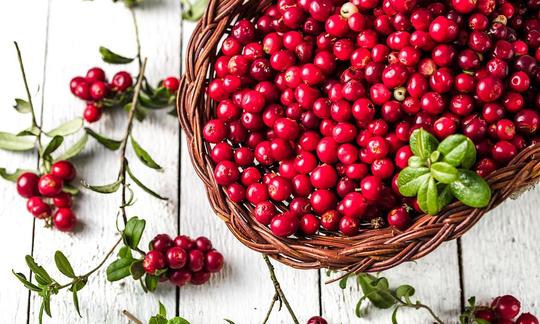

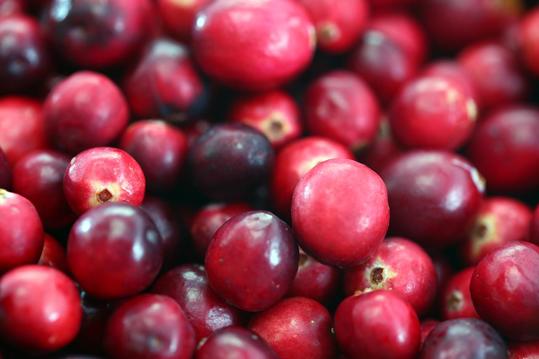

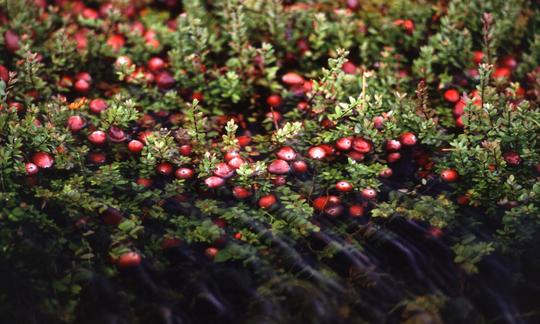

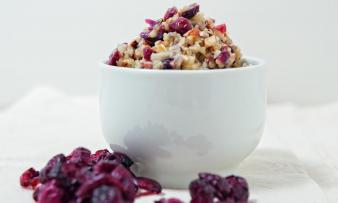
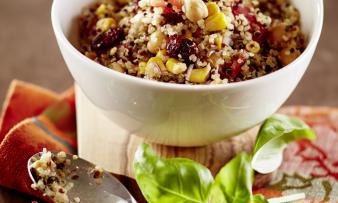





Comments